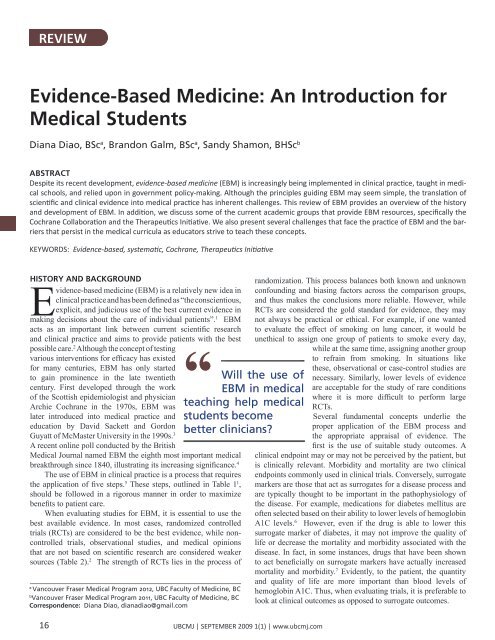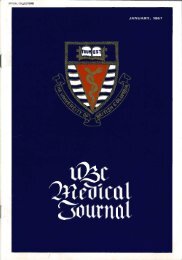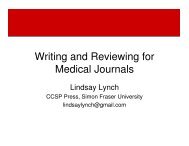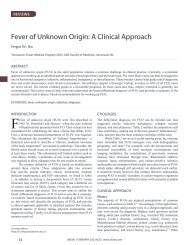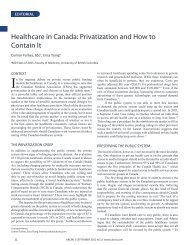Download article - UBC Medical Journal
Download article - UBC Medical Journal
Download article - UBC Medical Journal
You also want an ePaper? Increase the reach of your titles
YUMPU automatically turns print PDFs into web optimized ePapers that Google loves.
REVIEW<br />
Evidence-Based Medicine: An Introduction for<br />
<strong>Medical</strong> Students<br />
Diana Diao, BSc a , Brandon Galm, BSc a , Sandy Shamon, BHSc b<br />
ABSTRACT<br />
Despite its recent development, evidence-based medicine (EBM) is increasingly being implemented in clinical practice, taught in medical<br />
schools, and relied upon in government policy-making. Although the principles guiding EBM may seem simple, the translation of<br />
scientific and clinical evidence into medical practice has inherent challenges. This review of EBM provides an overview of the history<br />
and development of EBM. In addition, we discuss some of the current academic groups that provide EBM resources, specifically the<br />
Cochrane Collaboration and the Therapeutics Initiative. We also present several challenges that face the practice of EBM and the barriers<br />
that persist in the medical curricula as educators strive to teach these concepts.<br />
KEYWORDS: Evidence-based, systematic, Cochrane, Therapeutics Initiative<br />
History and Background<br />
Evidence-based medicine (EBM) is a relatively new idea in<br />
clinical practice and has been defined as “the conscientious,<br />
explicit, and judicious use of the best current evidence in<br />
making decisions about the care of individual patients”. 1 EBM<br />
acts as an important link between current scientific research<br />
and clinical practice and aims to provide patients with the best<br />
possible care. 2 Although the concept of testing<br />
“<br />
various interventions for efficacy has existed<br />
for many centuries, EBM has only started<br />
to gain prominence in the late twentieth<br />
century. First developed through the work<br />
of the Scottish epidemiologist and physician<br />
Archie Cochrane in the 1970s, EBM was<br />
later introduced into medical practice and<br />
education by David Sackett and Gordon<br />
Guyatt of McMaster University in the 1990s. 3<br />
A recent online poll conducted by the British<br />
<strong>Medical</strong> <strong>Journal</strong> named EBM the eighth most important medical<br />
breakthrough since 1840, illustrating its increasing significance. 4<br />
The use of EBM in clinical practice is a process that requires<br />
the application of five steps. 5 These steps, outlined in Table 1 1 ,<br />
should be followed in a rigorous manner in order to maximize<br />
benefits to patient care.<br />
When evaluating studies for EBM, it is essential to use the<br />
best available evidence. In most cases, randomized controlled<br />
trials (RCTs) are considered to be the best evidence, while noncontrolled<br />
trials, observational studies, and medical opinions<br />
that are not based on scientific research are considered weaker<br />
sources (Table 2). 2 The strength of RCTs lies in the process of<br />
a<br />
Vancouver Fraser <strong>Medical</strong> Program 2012, <strong>UBC</strong> Faculty of Medicine, BC<br />
b<br />
Vancouver Fraser <strong>Medical</strong> Program 2011, <strong>UBC</strong> Faculty of Medicine, BC<br />
Correspondence: Diana Diao, dianadiao@gmail.com<br />
Will the use of<br />
EBM in medical<br />
teaching help medical<br />
students become<br />
better clinicians<br />
randomization. This process balances both known and unknown<br />
confounding and biasing factors across the comparison groups,<br />
and thus makes the conclusions more reliable. However, while<br />
RCTs are considered the gold standard for evidence, they may<br />
not always be practical or ethical. For example, if one wanted<br />
to evaluate the effect of smoking on lung cancer, it would be<br />
unethical to assign one group of patients to smoke every day,<br />
while at the same time, assigning another group<br />
to refrain from smoking. In situations like<br />
these, observational or case-control studies are<br />
necessary. Similarly, lower levels of evidence<br />
are acceptable for the study of rare conditions<br />
where it is more difficult to perform large<br />
RCTs.<br />
Several fundamental concepts underlie the<br />
proper application of the EBM process and<br />
the appropriate appraisal of evidence. The<br />
first is the use of suitable study outcomes. A<br />
clinical endpoint may or may not be perceived by the patient, but<br />
is clinically relevant. Morbidity and mortality are two clinical<br />
endpoints commonly used in clinical trials. Conversely, surrogate<br />
markers are those that act as surrogates for a disease process and<br />
are typically thought to be important in the pathophysiology of<br />
the disease. For example, medications for diabetes mellitus are<br />
often selected based on their ability to lower levels of hemoglobin<br />
A1C levels. 6 However, even if the drug is able to lower this<br />
surrogate marker of diabetes, it may not improve the quality of<br />
life or decrease the mortality and morbidity associated with the<br />
disease. In fact, in some instances, drugs that have been shown<br />
to act beneficially on surrogate markers have actually increased<br />
mortality and morbidity. 7 Evidently, to the patient, the quantity<br />
and quality of life are more important than blood levels of<br />
hemoglobin A1C. Thus, when evaluating trials, it is preferable to<br />
look at clinical outcomes as opposed to surrogate outcomes.<br />
16<br />
<strong>UBC</strong>MJ | SEPTEMBER 2009 1(1) | www.ubcmj.com
REVIEW<br />
Table 1. Steps Involved in the Use of Evidence-Based Medicine<br />
1. Defined and focused clinical question<br />
2. Thorough search of the appropriate literature for all relevant<br />
clinical trials<br />
3. Critical appraisal of the collected evidence<br />
4. Patient-centred decision making<br />
5. Monitoring of clinical outcomes<br />
EBM in Practice<br />
One of the central, but arguably most challenging, aspects of<br />
modern medicine is keeping informed of the latest research.<br />
In order to assist physicians with this task, systematic reviews<br />
have become an important component of the practice of EBM.<br />
A systematic review is the process whereby all available clinical<br />
trials that seek to answer a clinical question and meet predefined<br />
inclusion criteria are aggregated into an analysis in order to create an<br />
overall conclusion. Once a systematic review has been performed,<br />
updates with new relevant research are expected. Some groups,<br />
such as the Cochrane<br />
“<br />
C o l l a b o r a t i o n ,<br />
require such updates<br />
be performed at least<br />
every two years.<br />
These reviews are<br />
especially useful to<br />
practicing clinicians<br />
as they are designed<br />
to provide a<br />
summary of the<br />
Many medical<br />
schools are moving<br />
away from teaching<br />
methods of critical<br />
appraisal...and instead<br />
simply emphasizing<br />
the implementation of<br />
evidence.<br />
relevant clinical<br />
points that can be<br />
applied in medical<br />
practice.<br />
There are several independent organizations around the world<br />
that are involved in producing systematic reviews. The largest<br />
and most comprehensive is the Cochrane Collaboration, which<br />
was founded in 1992 and named in honour of Archie Cochrane,<br />
a pioneer in the use of randomized controlled trials. 8 It is a nonprofit<br />
organization with centers distributed internationally. At<br />
each centre, experts in EBM produce systematic reviews that<br />
appraise and summarize evidence from many trials on a particular<br />
topic. This type of evidence arguably ranks the highest because it<br />
critically appraises and interprets the evidence and then provides<br />
both the clinical implications and future research directions.<br />
Another major organization involved in producing evidencebased<br />
reports is the Therapeutics Initiative (TI), which was<br />
established in 1994 in the Department of Pharmacology and<br />
Therapeutics at the University of British Columbia. 9 The<br />
TI addresses controversial topics in medicine through short<br />
“Therapeutic Letters”, which are published every two months.<br />
The goal of these letters is to provide evidence-based prescription<br />
drug therapy after an extensive review of the most current<br />
literature by the Drug Assessment Working Group of the TI.<br />
Before the letters are published, drafts are reviewed by all the<br />
members of the TI, including experts in a particular therapeutic<br />
area. As a member of the International Society of Drug Bulletins<br />
and of the Cochrane Collaboration, the TI has both international<br />
and local impact through the dissemination of its Therapeutic<br />
Letters and other evidence-based reports on its website.<br />
As an example, in letter 62, the TI provides a case scenario<br />
to investigate the benefit gained from treating a patient with mild<br />
hypertension, defined as a blood pressure (BP) in the range of<br />
140-160/90-100 mmHg. 10 They conducted a best-evidence search<br />
and concluded that treating patients within this BP range for<br />
five years achieves, on average, a 0.8% absolute risk reduction<br />
for total cardiovascular events. These results indicate that 125<br />
patients must be treated with anti-hypertensive medications<br />
for five years in order to prevent one heart attack or stroke; in<br />
other words, the number needed to treat (NNT) would be 125<br />
patients for five years. In addition, no significant reduction in<br />
total mortality was demonstrated. Should the patient therefore be<br />
treated It is important that the patient understands the probability<br />
of benefit and participates in the decisions regarding treatment.<br />
This scenario demonstrates the complexity and difficulty of using<br />
EBM in practice. The fundamental message is that even the best<br />
evidence should not be blindly applied based on well-memorized<br />
cut-offs without placing the patient in context.<br />
EBM in the <strong>Medical</strong> Curriculum<br />
Careful practice of EBM by physicians and residents can help<br />
improve patient outcomes in the clinical setting, but will the use of<br />
EBM in teaching help medical students become better clinicians<br />
Over the past decade, EBM has become increasingly integrated<br />
into the curricula of many medical schools. This change has been<br />
shown to improve students’ ability to develop clinical questions<br />
and perform effective literature searches. 11 Evaluation of a<br />
longitudinal EBM curriculum has also shown an association with<br />
an increased breadth of knowledge of EBM that was sustained<br />
throughout the entire curriculum. 12 However, much work remains<br />
to be done in developing an effective curriculum for teaching<br />
EBM. One study evaluated perceived competence and actual<br />
performance in EBM techniques among medical graduates and<br />
found that, although many felt competent, the average score of the<br />
students was only 55% correct. 13<br />
In shaping their EBM curricula, many medical schools are<br />
moving away from teaching methods of critical appraisal, which<br />
form the basis of EBM, and instead simply emphasizing the<br />
implementation of evidence. 14 It is crucial that critical appraisal<br />
Table 2. Levels of Evidence by Study Design<br />
Level<br />
Ia<br />
Ib<br />
IIa<br />
IIb<br />
III<br />
IV<br />
Investigation Design<br />
Meta-analysis of many RCTs<br />
At least one large RCT<br />
One controlled trial, without randomization<br />
Controlled cohort or case-control studies<br />
Non-experimental observational studies<br />
Case reports and clinical opinions<br />
<strong>UBC</strong>MJ | SEPTEMBER 2009 1(1) | www.ubcmj.com 17
REVIEW<br />
of evidence be applied at all levels of EBM. The term “evidencebased”<br />
may be used incorrectly or out of context, and it is important<br />
to consider factors such as for-profit funding, inappropriate<br />
controls, use of surrogate outcomes, publication and reporting<br />
biases and misleading reporting, when assessing the validity<br />
of individual studies or reviews. 14 This is the rationale behind<br />
the need to teach principles of EBM in addition to applying it<br />
in practice. Although systematic reviews are deemed to be the<br />
strongest form of medical evidence, not all systemic reviews<br />
follow the same set of standardized methodology or are of equal<br />
quality and reliability. A poorly conducted systematic review<br />
may not be immediately obvious to the reader. Additionally,<br />
many systematic reviews are not current; only Cochrane reviews<br />
are reliably updated every two years. Thus, simply reading the<br />
conclusion of a systematic review is seldom sufficient.<br />
Challenges Facing EBM<br />
While EBM may seem to be the calling of medicine in the twentyfirst<br />
century, there are many barriers that EBM faces before it can<br />
become completely accepted as the standard in patient care. While<br />
some arguments against EBM are based on misunderstandings,<br />
other concerns are legitimate and must be addressed. A common<br />
criticism is that EBM is a clinical cookbook for physicians to apply<br />
to every patient with a certain illness. However, it is important to<br />
understand that EBM is only one component of clinical practice:<br />
the goal of EBM is to allow the physician to integrate patient<br />
preferences with clinical judgment and appropriate evidence. 14<br />
Another misconception is that only the results of RCTs should be<br />
used as a basis for clinical recommendations. While RCTs may<br />
be desirable, they are not, as discussed earlier, suitable for all<br />
situations and outcomes. 14 EBM strives to use the best available<br />
evidence, which may not always be the best form of evidence (i.e.,<br />
when RCTs are not available). Finally, a lack of evidence in the<br />
literature is not equivalent proof that a certain intervention lacks<br />
effectiveness. 14 EBM serves to identify knowledge gaps in the<br />
literature, acting as an important stimulus for additional RCTs.<br />
There exist other genuine concerns that need to be addressed<br />
before EBM becomes more widely accepted. The greatest<br />
challenge now is identifying ways to modify clinical behaviour<br />
so that EBM is used routinely by practicing physicians. 15 As<br />
in any professional field, there is often resistance to change.<br />
Barriers to the adoption of EBM often cited by physicians include<br />
feasibility, time constraints, and inadequate resources. 15 In a<br />
study of surgical residents, challenges faced in the application of<br />
EBM were categorized as 1) at the institutional level, where the<br />
availability of resources and time needed to obtain them is limited;<br />
2) at the resident level, where the motivation and desire to apply<br />
literature to practice is lacking and resistance from attending staff<br />
is sensed; and 3) at the attending level, where there is inadequate<br />
EBM knowledge and practice. All three factors impeded the use<br />
of EBM. 15<br />
Finally, the private sector constitutes another substantial<br />
barrier to the proper implementation of EBM. Several of these<br />
issues have been raised previously, including for-profit funding<br />
of research trials and the marketing of medications based on<br />
surrogate outcomes. Pharmaceutical companies may oppose<br />
EBM when it conflicts with their marketing strategies and when<br />
certain medications, which may be more costly than oldergeneration<br />
drugs, are not shown to be any better in terms of<br />
clinical outcomes. It is also imperative to consider the influence<br />
that the pharmaceutical industry has on the development of<br />
clinical guidelines. Unfortunately, many current guidelines do not<br />
follow EBM principles as they are funded by groups with a vested<br />
interest. It is therefore vital that clinicians view recommended<br />
guidelines critically and be aware of biases when applying them<br />
in practice.<br />
Summary<br />
Although EBM continues to evolve and play a key role in providing<br />
systematic reviews to answer crucial questions in medical<br />
practice, there remain numerous challenges in the dissemination,<br />
acceptance, and application of that evidence. The principles of<br />
EBM are rooted in the use of the best-possible study designs,<br />
large sample sizes, and the careful and unbiased interpretation of<br />
the best available evidence to support or oppose given medical<br />
treatments or interventions. However, although EBM may help<br />
provide a fundamental framework for practitioners in the delivery<br />
of health care, it must be applied appropriately and be sensitive to<br />
the needs of individual patients.<br />
References<br />
1. Sackett DL, Rosenberg WM, Gray JA, Haynes RB, Richardson WS.<br />
Evidence-based medicine: what it is and what it isn’t. BMJ 1996<br />
312:71-72.<br />
2. Antes G, Galandi D, Bouillon B. What is evidence-based medicine<br />
Langenbeck’s Arch Surg 1999 384:409–416.<br />
3. Ghosh AK. Clinical applications and update on evidence-based<br />
medicine. JAPI 2007 55:787-794.<br />
4. <strong>Medical</strong> Milestones [Online]. 2007 Jan 6 [Cited 2009 Mar 23];[2<br />
screens]. Available from: URL: http://www.bmj.com/cgi/content/<br />
full/334/suppl_1/DC3 .<br />
5. Sackett DL, Rosenberg WMC. The need for evidence-based medicine.<br />
J R Soc Med 88: 620-624.<br />
6. Tosi F, Muggeo M, Brun E, Spiazzi G, Perobelli L, Zanolin E, et al.<br />
Combination treatment with metformin and glibenclamide versus<br />
single-drug therapies in type 2 diabetes mellitus: a randomized,<br />
double-blind, comparative study. Metabolism 2003 52: 862-7.<br />
7. Baron JA, Sandler RS, Bresalier RS, Lanas A, Morton DG, Riddell R,<br />
et al. Cardiovascular events associated with rofecoxib: final analysis<br />
of the APPROVe trial. Lancet 2008 372: 1756-64.<br />
8. The Cochrane Collaboration. About the Cochrane collaboration<br />
[online]. [Cited 2009 Mar 23]; Available from: URL: http://www.<br />
cochrane.org/docs/descrip.htm.<br />
9. Therapeutics Initiative. Overview [online]. [Cited 2009 Mar 23]:<br />
Available from: URL: http://www.ti.ubc.ca/AboutUs.<br />
10. Therapeutics Initiative. Mild hypertension, an approach to using<br />
evidence in the decision making process. TI [serial online] 2007 Jan-<br />
Feb [cited 2009 Mar 23rd], letter 62: [2 screens]. Available from:<br />
URL: http://www.ti.ubc.ca/PDF/62.pdf.<br />
11. Taheri H, Mirmohamadsadeghi M, Adibi I, Ashorion V, Sadeghizade<br />
A, Adibi P. Evidence-based Medicine (EBM) for Undergraduate<br />
<strong>Medical</strong> Students. Ann Acad Med Singapore 2008 37:764-8.<br />
12. West CP. McDonald FS. Evaluation of a longitudinal medical school<br />
evidence-based medicine curriculum: a pilot study. J Intern Med 2008<br />
23:1057-9.<br />
13. Lui JC, Stewart MG. Teaching Evidence-Based Medicine in<br />
Otolaryngology. Otolaryngol Clin N Am 2007 40:1261-1274.<br />
14. Montori VM, Guyatt GH. Progress in Evidence-Based Medicine.<br />
JAMA 2008 300:1814-1816.<br />
15. Barratt A. Evidence Based Medicine and Shared Decision Making:<br />
The challenge of getting both evidence and preferences into health<br />
care. Patient Educ Couns 2008 73:407-412.<br />
18<br />
<strong>UBC</strong>MJ | SEPTEMBER 2009 1(1) | www.ubcmj.com


